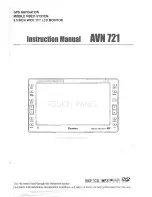
Quick Guide to using the Garmin 76CS GPS Unit
Initialization
Getting Started
Turn on the GPS unit by pressing down the red power button on the left. By default, the receiver will
begin "initialization", searching for overhead satellites in order to determine (fix) its location. This
process can take from 5 to 15 minutes. You must be outdoors with a clear view of the sky.
To shorten the time required:
1. From the Satellites page, press the MENU button,
2. Scroll to New Location (using the center ROCKER button),
3. Press ENTER,
4. Scroll to Use Map, and press ENTER again.
5. Use the ROCKER button to move the cursor over the display map, and the ZOOM IN and OUT
buttons to find your approximate location, then press ENTER.
The initialization process will now focus its search for satellites in your area. As the GPS unit finds
satellites, the Locating Satellites message will change to Acquiring Satellites. Once three or more are
found (four needed for 3 dimensional orientation), a location can be determined.
Configuration
There are a variety of settings accessible from each of the pages as well as the Main Menu page.
You can cycle though pages by pushing the PAGE button. To open the menu options for a page,
press MENU. For the Main menu page, use the ROCKER button to select the appropriate sub menu.
If you wish to stop the initialization (acquiring satellites) process temporarily after powering up, from
the Satellite page press MENU, then ( with Use with GPS Off highlighted), press ENTER. You can
now conserve battery power during configuration. The PAGE button can also be held down to toggle
the compass on or off.
Datum and coordinate system:
In GIS, it is critical that the datum and coordinate system of your data,
including base map data, are explicitly defined (and ultimately the same). Before collecting data,
make sure the GPS unit is set to the coordinate system and datum that best matches your needs
(those who are using DNR Garmin will download data as GCS WGS 84 –see Downloading Data
section for changing projection after download).
1. From the Main Menu page, select Setup.
2. Scroll down and select Units.
3. Select the Position Format (coordinate system) you wish the output coordinates to be in. If you're
using a geographic coordinate system (GCS), latitude and longitude should be expressed as
decimal degrees (hddd.ddddd) rather than degrees, minutes and seconds. You can convert DMS
to DD later if you do not select DD before collecting data. You can also change (reproject) the
coordinate system of your data if needed. See the Mann Library GPS tutorial for instructions on
data conversion. Select UTM UPS for Universal Transverse Mercator coordinates. If you are
working with State Plane data, select User UTM Grid. You will need to configure some settings -
go to http://gpsinformation.net/state-plane.html for details, where you can download a table
http://gpsinformation.net/mapinfow-e.xls listing the information you will need.






















